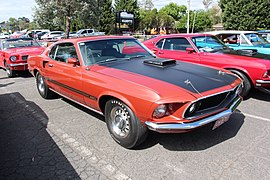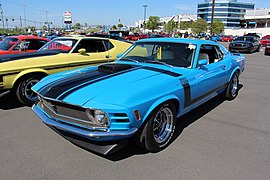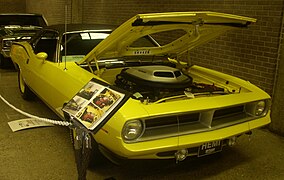Shaker scoop

A shaker scoop (sometimes called a shaker hood scoop or a shaker hood) is an automobile term for an air intake for combustion air that is mounted directly on top of the engine's air cleaner and protrudes through a hole in the hood. Since it is fastened directly to the engine, it moves with the engine's movement and vibration on its mountings, thus the 'shaker' name.
Design
[edit]Like all such scoops, its purpose is to increase performance by a 'ram air' effect, taking advantage of the vehicle's speed to deliver high pressure, cool air to the engine over a shorter, less restrictive flow path.[1] However, because engines draw air in hundreds of cubic feet per minute, scoops do not raise intake pressures significantly.[2] Additional claimed benefits of a shaker hood include elevation to prevent water from being drawn on flooded terrain, being a source of cooler, denser air, and having a more direct path to the engine's throttle plate.[1]
Aftermarket
[edit]
Hot rod and drag race enthusiasts have modified automotive engines to increase power via supercharger forced induction since the 1920s; in some cases, a blower scoop is added to the top of the supercharger as an aid to air intake.
A vehicle also can be equipped with an aftermarket engine-mounted scoop that is mounted directly to the carburetor and protrudes through the hood, which is known as a carb scoop. Carb scoops are sometimes mistaken for blower scoops, but the presence (or lack) of a belt to drive the supercharger is one way to distinguish these scoops. Both carb and blower scoops are sometimes called bugcatchers. Like the shaker scoop, both a blower scoop and a carb scoop will vibrate in response to engine motions because they are attached to the engine.
Some aftermarket scoops include butterfly valves, which act as secondary throttle bodies.[3]
Factory-fitted
[edit]


Larry Shinoda of Ford is credited with introducing the shaker hood scoop as a factory-fitted option and campaigning to make it functional, first available exclusively for the 1969 model year Mustang equipped with the 428 Cobra Jet engine;[4] the option was expanded to other Ford Mustang engines for 1970 and imitated quickly by competitors Chrysler (1970 Plymouth 'cuda and Dodge Challenger) and Pontiac (19701⁄2 Firebird Trans Am, which used a backwards-facing scoop to draw air from the high-pressure area at the base of the windshield).[5] Some official Chrysler literature referred to this popular hood style as the "Incredible Quivering Exposed Cold Air Grabber".[6] This lengthy title has since been shortened by enthusiasts and collectors to the less tongue-twisting "shaker hood".
In the 2000s, factory-fitted shaker scoops were reintroduced with the Ford Mustang (2003 Mach 1)[7] and Dodge Challenger (2014 "Shaker" package).[2]
Examples
[edit]-
1970 Boss 302 Mustang
-
1970 Plymouth 'cuda
-
1970 Dodge Challenger
-
1970 Ford Torino GT
-
1974 Pontiac Ventura (GTO)
-
1977 Pontiac Can Am
-
2003 Ford Mustang Mach 1
-
2014 Dodge Challenger R/T
Such scoops were fitted to a variety of cars, including:
- 1969 Ford Mustang Cobra Jet
- 1970 Boss 302 Mustang
- 1970 Plymouth Barracuda
- Dodge Challenger
- Ford Torino
- Pontiac GTO
- Pontiac Firebird Trans Am
- Pontiac Can Am Grand Am
- Ford Falcon XY GT Phase III
- 2004 Ford Mustang Mach 1
References
[edit]- ^ a b Fernie, Michael (2016). "What is a shaker hood and how do they work?". Car Throttle. Retrieved 27 October 2022.
- ^ a b Raynal, Wes; Kozak, Graham; Lingeman, Jake (October 6, 2014). "2014 Dodge Challenger R/T Shaker review notes". Autoweek. Retrieved 27 October 2022.
What's the point of the Shaker hood? I dunno -- what has the point of a Shaker hood ever been? The performance advantages are debatable, so I guess you buy one because you think it looks cool.
- ^ "Air Scoops". Holley Performance Products. Retrieved 27 October 2022.
- ^ Shaw, Tom (September 21, 2016). "Show-Quality Shaker Hood Scoop Detailing". Motor Trend. Retrieved 27 October 2022.
- ^ O'Clair, Jim (September 24, 2018). "Shaker-Style Hood Scoops". Hemmings. Retrieved 27 October 2022.
- ^ "1970 Dodge Charger (brochure)". Chrysler Motor Corporation. 1970.
- ^ "2003 Ford Mustang Mach 1". Ford Performance. Retrieved 27 October 2022.











